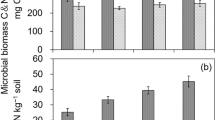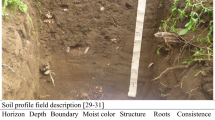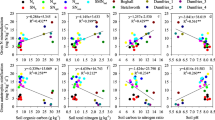Abstract
Background and aims
Dissolved organic matter (DOM) is an active component of the soil organic carbon (SOC) and nitrogen (N) pool. However, the relationship between DOM chemodiversity and microbial communities, and their effects on the C and N in paddy fields under organic or inorganic fertilization, are poorly understood but important for sustainable agricultural production.
Methods
We conducted a six-year experiment in paddy fields under the following different organic and inorganic fertilizer treatments: no fertilizer (CK), chemical fertilizer (150 kg·hm−2 N; CF), 50% N from chemical fertilizer + 50% N from decomposed cattle manure (CMF50), and manure fertilizer (100% N from decomposed cattle manure; MF).
Results
CMF50 exhibited the highest yield (10.89% increase compared with CF). MF and CMF50 enriched the availability and content of soil N, which in turn exhibited a strong effect on net N mineralization and increased SOC and the amount of recalcitrant components of DOM. However, the continuous use of CF led to an increase in both soil bulk density and the number of anaerobic organisms Anaerolinea and Bellilinea. The fractions of DOM containing lignin-like and lipid-like compounds were strongly correlated with Anaerolinea and Bellilinea and contributed to net N mineralization and SOC. Continuous use of CF facilitated net N mineralization but decreased both DOC and SOC.
Conclusions
Continuous applications of CMF50 and MF improved the microbial communities and increased the recalcitrant components of DOM, thus highlighting the importance of the relationship between DOM composition and soil microbial communities while assessing the soil N and SOC.





Similar content being viewed by others
Data availability
The datasets generated during and/or analyzed during the current study are available from the corresponding author on reasonable request.
Abbreviations
- AI:
-
Aromaticity index
- AN:
-
Alkali-hydrolysable N
- CF:
-
Chemical fertilizer
- CK:
-
No fertilizer
- CMF50:
-
50% N from chemical fertilizer + 50% N from decomposed cattle manure
- DBE-O:
-
Double bond equivalence minus oxygen value
- DOC:
-
Dissolved organic carbon
- DOM:
-
Dissolved organic matter
- FT-ICR-MS:
-
Fourier-transform ion cyclotron resonance mass spectrometry
- MF:
-
Manure fertilizer
- OTU:
-
Operational taxonomic units
- SOC:
-
Soil organic carbon
- RDA:
-
Redundancy analysis
- SPE:
-
Solid-phase extraction
- TN:
-
Total nitrogen
References
Alam M, Rahman M, Biswas JC, Akhter S, Maniruzzaman M, Choudhury AK, Jahan MAHS, Miah MMU, Sen R, Kamal MZU, Mannan MA, Shiragi HK, Kabir W, Kalra N (2019) Nitrogen transformation and carbon sequestration in wetland paddy field of Bangladesh. Paddy Water Environ 17:677–688. https://doi.org/10.1007/s10333-019-00693-7
Bai Z, Caspari T, Gonzalez MR, Batjes NH, Mäder P, Bünemann EK, de Goede R, Brussaard L, Xu M, Ferreira CSSF, Reintam E, Fan H, Mihelič R, Glavan M, Tóth Z (2018) Effects of agricultural management practices on soil quality: a review of long-term experiments for Europe and China. Agric Ecosyst Environ 265:1–7. https://doi.org/10.1016/j.agee.2018.05.028
Bouman M, Lampayan RM, Tuong TP (2007) Coping with water scarcity. In: Hardy B (ed) Water Management in Irrigated Rice. International Rice Research Institute, Los Baños, pp 17–22
Boye K, Noël V, Tfaily MM, Bone SE, Williams KH, Bargar JR, Fendorf S (2017) Thermodynamically controlled preservation of organic carbon in floodplains. Nat Geosci 10:415–419. https://doi.org/10.1038/ngeo2940
Caporaso JG, Lauber CL, Walters WA, Berglyons D, Huntley J, Fierer N, Owens SM, Betley J, Fraser L, Bauer M (2012) Ultra-high-throughput microbial community analysis on the Illumina HiSeq and MiSeq platforms. ISME J 6:1621. https://doi.org/10.1038/ismej.2012.8
Caporaso JG, Lauber CL, Walters WA, Lyons DB, Lozupone CA, Turnbaugh PJ, Fierer N, Knight R (2011) Global patterns of 16S rRNA diversity at a depth of millions of sequences per sample. PNAS 108:4516–4522. https://doi.org/10.1073/pnas.1000080107
Celik I, Gunal H, Budak M, Akpinar C (2010) Effects of long-term organic and mineral fertilizers on bulk density and penetration resistance in semi-arid Mediterranean soil conditions. Geoderma 160:236–243. https://doi.org/10.1016/j.geoderma.2010.09.028
Chong G, Huang X, Di J, Xu D, He Y, Pei Y, Tang Y, Ma C (2018) Biodegradation of alkali lignin by a newly isolated Rhodococcus pyridinivorans CCZU-B16. Bioproc Biosyst Eng 41:501–510. https://doi.org/10.1007/s00449-017-1884-x
Colatriano D, Tran PQ, Guéguen C, Williams WJ, Lovejoy C, Walsh DA (2018) Genomic evidence for the degradation of terrestrial organic matter by pelagic Arctic Ocean Chloroflexi bacteria. Commun Biol 1:1–9. https://doi.org/10.1038/s42003-018-0086-7
Coonan EC, Kirkby CA, Kirkegaard JA, Amidy MR, Strong CL, Richardson AE (2020) Microorganisms and nutrient stoichiometry as mediators of soil organic matter dynamics. Nutr Cycl Agroecosys 117:273–298. https://doi.org/10.1007/s10705-020-10076-8
Craine JM, Morrow C, Fierer N (2007) Microbial nitrogen limitation increases decomposition. Ecology 88:2105–2113. https://doi.org/10.1890/06-1847.1
Devi MP, Subhash GV, Mohan SV (2012) Heterotrophic cultivation of mixed microalgae for lipid accumulation and wastewater treatment during sequential growth and starvation phases: effect of nutrient supplementation. Renew Energy 43:276–283. https://doi.org/10.1016/j.renene.2011.11.021
Ding Y, Shi Z, Ye Q, Liang Y, Liu M, Dang Z, Wang Y, Liu C (2020) Chemodiversity of soil dissolved organic matter. Environ Sci Technol 54:6174–6184. https://doi.org/10.1021/acs.est.0c01136
Ekenler M, Tabatabai M (2004) β-Glucosaminidase activity as an index of nitrogen mineralization in soils. Commun Soil Sci Plan 35:1081–1094. https://doi.org/10.1081/CSS-120030588
Fang Z, He C, Li Y, Chung KH, Xu C, Shi Q (2017) Fractionation and characterization of dissolved organic matter (DOM) in refinery wastewater by revised phase retention and ion-exchange adsorption solid phase extraction followed by ESI FT-ICR MS. Talanta 162:466–473. https://doi.org/10.1016/j.talanta.2016.10.064
Feng L, Xu J, Kang S, Li X, Li Y, Jiang B, Shi Q (2016) Chemical composition of microbe-derived dissolved organic matter in cryoconite in Tibetan plateau glaciers: insights from fourier transform ion cyclotron resonance mass spectrometry analysis. Environ Sci Technol 50:13215. https://doi.org/10.1021/acs.est.6b03971
Fujii K, Yamada T, Hayakawa C, Nakanishi A, Funakawa S (2018) Another bottleneck for nitrogen mineralization in temperate forest soils: arginine metabolism in microorganisms. Soil Biol Biochem 126:22–30. https://doi.org/10.1016/j.soilbio.2018.08.005
Gai X, Liu H, Liu J, Zhai L, Yang B, Wu S, Ren T, Lei Q, Wang H (2018) Long-term benefits of combining chemical fertilizer and manure applications on crop yields and soil carbon and nitrogen stocks in North China Plain. Agric Water Manag 208:384–392. https://doi.org/10.1016/j.agwat.2018.07.002
Ghosh A, Bhattacharyya R, Meena MC, Dwivedi BS, Singh G, Agnihotri R, Sharma C (2018) Long-term fertilization effects on soil organic carbon sequestration in an Inceptisol. Soil till Res 177:134–144. https://doi.org/10.1016/j.still.2017.12.006
Guo P, Zhang C, Wang Y, Yu X, Zhang Z, Zhang D (2018) Effect of long-term fertilization on humic redox mediators in multiple microbial redox reactions. Environ Pollut 234:107–114. https://doi.org/10.1016/j.envpol.2017.10.106
He C, Wang H, Peng X, Li H (2022) Recent biotechnology advances in bio-conversion of lignin to lipids by bacterial cultures. Front Chem 393. https://doi.org/10.3389/fchem.2022.894593
Hou Y, Wei S, Ma W, Roelcke M, Nieder R, Shi S, Wu J, Zhang F (2018) Changes in nitrogen and phosphorus flows and losses in agricultural systems of three megacities of China, 1990–2014. Resour Conserv Recy 139:64–75. https://doi.org/10.1016/j.resconrec.2018.07.030
Huang M, Li Z, Chen M, Wen J, Luo N, Xu W, Ding X, Xing W (2020) Dissolved organic matter released from rice straw and straw biochar: contrasting molecular composition and lead binding behaviors. Sci Total Environ 739:140378. https://doi.org/10.1016/j.scitotenv.2020.140378
Jeewani PH, Gunina A, Tao L, Zhu Kuzyakov Y, Van Zwieten L, Guggenberger G, Shen C, Yu G, Singh BP, Pan S, Luo Y, Xu J (2020) Rusty sink of rhizodeposits and associated keystone microbiomes. Soil Biol Biochem 147:107840. https://doi.org/10.1016/j.soilbio.2020.107840
Jin Z, Chen C, Chen X, Jiang F, Hopkins I, Zhang X, Han Z, Billy G, Benavides J (2019) Soil acidity, available phosphorus content, and optimal biochar and nitrogen fertilizer application rates: a five-year field trial in upland red soil, China. Field Crop Res 232:77–87. https://doi.org/10.1016/j.fcr.2018.12.013
Jones DL, Willett VB (2006) Experimental evaluation of methods to quantify dissolved organic nitrogen (DON) and dissolved organic carbon (DOC) in soil. Soil Biol Biochem 38:991–999. https://doi.org/10.1016/j.soilbio.2005.08.012
Kirk TK, Connors WJ, Zeikus JG (1976) Requirement for a growth substrate during lignin decomposition by two wood-rotting fungi. Appl Environ Microb 32:192–194. https://doi.org/10.1128/aem.32.1.192-194.1976
Lee S, Kang M, Bae JH, Sohn JH, Sung BH (2019) Bacterial valorization of lignin: strains, enzymes, conversion pathways, biosensors, and perspectives. Front Bioeng Biotech 209. https://doi.org/10.3389/fbioe.2019.00209
Li HY, Wang H, Wang HT, Xin PY, Xu XH, Ma Y, Liu WP, Ten CY, Jiang CL, Lou LP, Arnold W, Cralle L, Zhu YG, Chu JF, Gilbert JA, Zhang ZJ (2018a) The chemodiversity of paddy soil dissolved organic matter correlates with microbial community at continental scales. Microbiome 6:1–16. https://doi.org/10.1186/s40168-018-0561-x
Li M, Sun G, Chen S, Fang Z, Yun H, Shi Q, Zhu Y (2018b) Molecular chemodiversity of dissolved organic matter in paddy soils. Environ Sci Technol 52:963–971. https://doi.org/10.1021/acs.est.7b00377
Li J, Wen Y, Li X, Li Y, Yang X, Lin Z, Song Z, Cooper JM, Zhao B (2018c) Soil labile organic carbon fractions and soil organic carbon stocks as affected by long-term organic and mineral fertilization regimes in the North China Plain. Soil till Res 175:281–290. https://doi.org/10.1016/j.still.2017.08.008
Li X, Chen Q, He C, Shi Q, Chen S, Reid BJ, Zhu Y, Sun G (2018d) Organic carbon amendments affect the chemodiversity of soil dissolved organic matter and its associations with soil microbial communities. Environ Sci Technol 53:50–59. https://doi.org/10.1021/acs.est.8b04673
Li Y, Nie C, Liu Y, Du W, He P (2019) Soil microbial community composition closely associates with specific enzyme activities and soil carbon chemistry in a long-term nitrogen fertilized grassland. Sci Total Environ 654:264–274. https://doi.org/10.1016/j.scitotenv.2018.11.031
Li Y, Heal K, Wang S, Cao S, Zhou C (2021) Chemodiversity of soil dissolved organic matter and its association with soil microbial communities along a chronosequence of Chinese Fir monoculture plantations. Front Microbiol 12:729344. https://doi.org/10.3389/fmicb.2021.729344
Ling L, Fu Y, Jeewani PH, Tang C, Pan S, Reid BJ, Gunina A, Li Y, Li Y, Cai Y, Kuzyakov Y, Li Y, Su W, Singh BP, Luo Y, Xu J (2021) Organic matter chemistry and bacterial community structure regulate decomposition processes in post-fire forest soils. Soil Biol Biochem 160:108311. https://doi.org/10.1016/j.soilbio.2021.108311
Lv J, Zhang S, Wang S, Luo L, Cao D, Christie P (2016) Molecular-scale investigation with ESI-FT-ICR-MS on fractionation of dissolved organic matter induced by adsorption on iron oxyhydroxides. Environ Sci Technol 50:2328–2336. https://doi.org/10.1021/acs.est.5b04996
Ly QV, Hur J (2018) Further insight into the roles of the chemical composition of dissolved organic matter (DOM) on ultrafiltration membranes as revealed by multiple advanced DOM characterization tools. Chemosphere 201:168–177. https://doi.org/10.1016/j.chemosphere.2018.02.181
Mickan BS, Abbott LK, Solaiman ZM, Mathes F, Siddique KH, Jenkins SN (2019) Soil disturbance and water stress interact to influence arbuscular mycorrhizal fungi, rhizosphere bacteria and potential for N and C cycling in an agricultural soil. Biol Fert Soils 55:53–66. https://doi.org/10.1007/s00374-018-1328-z
Moorhead DL, Sinsabaugh RL (2006) A theoretical model of litter decay and microbial interaction. Ecol Monogr 76:151–174. https://doi.org/10.1890/0012-9615(2006)076[0151:ATMOLD]2.0.CO;2
Mulvaney RL, Khan SA, Ellsworth TR (2009) Synthetic nitrogen fertilizers deplete soil nitrogen: a global dilemma for sustainable cereal production. J Environ Qual 38:2295–2314. https://doi.org/10.2134/jeq2008.0527
O’Donnell JA, Aiken GR, Butler KD, Guillemette F, Podgorski DC, Spencer RGM (2016) DOM composition and transformation in boreal forest soils: the effects of temperature and organic-horizon decomposition state. J Geophys Res-Biogeo 121:2727–2744. https://doi.org/10.1002/2016JG003431
Osterholz H, Singer G, Wemheuer B, Daniel R, Simon M, Niggemann J, Dittmar T (2016) Deciphering associations between dissolved organic molecules and bacterial communities in a pelagic marine system. ISME J 10:1717–1730. https://doi.org/10.1038/ismej.2015.231
Razanamalala K, Razafimbelo T, Maron P, Ranjard L, Chemidlin N, Lelièvre M, Dequiedt S, Ramaroson VH, Marsded C, Becquer T, Trap J, Blanchart E, Bernard L (2018) Soil microbial diversity drives the priming effect along climate gradients: a case study in Madagascar. ISME J 12:451–462. https://doi.org/10.1038/ismej.2017.178
Roba T (2018) Review on: the effect of mixing organic and inorganic fertilizer on productivity and soil fertility. OALib J 5:1–11. https://doi.org/10.4236/oalib.1104618
Rognes T, Flouri T, Nichols B, Quince C, Mahe F (2016) VSEARCH: a versatile open source tool for metagenomics. PeerJ 4:e2584. https://doi.org/10.7717/peerj.2584
Rong Y, Su Y, Tao W, Qin Y (2016) Effect of chemical and organic fertilization on soil carbon and nitrogen accumulation in a newly cultivated farmland. J Integr Agr 15:658–666. https://doi.org/10.1016/S2095-3119(15)61107-8
Šantl-Temkiv T, Finster K, Dittmar T, Hansen BM, Thyrhaug R, Nielsen NW, Karlson UG (2013) Hailstones: a window into the microbial and chemical inventory of a storm cloud. PLoS One 8:e53550. https://doi.org/10.1371/journal.pone.0053550
Sebastián M, Smith AF, González JM, Fredricks HF, Van Mooy B, Koblížek M, Brandsma J, Koster G, Mestre M, Mostajir B, Pitta P, Postle AD, Sánchez P, Gasol JM, Scanlan DJ, Chen Y (2016) Lipid remodelling is a widespread strategy in marine heterotrophic bacteria upon phosphorus deficiency. ISME J 10:968–978. https://doi.org/10.1038/ismej.2015.172
Shi K, Gao Z, Shi TQ, Song P, Ren L, Huang H, Ji X (2017) Reactive oxygen species-mediated cellular stress response and lipid accumulation in oleaginous microorganisms: the state of the art and future perspectives. Front Microbiol 8:793. https://doi.org/10.3389/fmicb.2017.00793
Wang J, Xiong Z, Kuzyakov Y (2016) Biochar stability in soil: meta-analysis of decomposition and priming effects. Glob Chang Biol 8:512–523. https://doi.org/10.1111/gcbb.12266
Weiwei L, Xin Y, Keqiang S, Baohua Z, Gao G (2018) Unraveling the sources and fluorescence compositions of dissolved and particulate organic matter (DOM and POM) in Lake Taihu, China. Environ Sci Pollu R 26:4027–4040. https://doi.org/10.1007/s11356-018-3873-2
Wong MT, Wang W, Lacourt M, Couturier M, Edwards EA, Master ER (2016) Substrate-driven convergence of the microbial community in lignocellulose-amended enrichments of gut microflora from the Canadian beaver (Castor canadensis) and North American moose (Alces americanus). Front Microbiol 7:961. https://doi.org/10.3389/fmicb.2016.00961
Wu H, Du S, Zhang Y, An J, Zou H, Zhang Y, Yu N (2019) Effects of irrigation and nitrogen fertilization on greenhouse soil organic nitrogen fractions and soil-soluble nitrogen pools. Agr Water Manag 216:415–424. https://doi.org/10.1016/j.agwat.2019.02.020
Xiong Y, Xia H, Li ZA, Cai XA, Fu S (2008) Impacts of litter and understory removal on soil properties in a subtropical Acacia mangium plantation in China. Plant Soil 304:179–188. https://doi.org/10.1007/s11104-007-9536-6
Xu Y, Feng J, Li H (2021) How intercropping and mixed systems reduce cadmium concentration in rice grains and improve grain yields. J Hazard Mater 402:123762. https://doi.org/10.1016/j.jhazmat.2020.123762
Yin L, Dijkstra FA, Wang P, Zhu B, Cheng C (2018) Rhizosphere priming effects on soil carbon and nitrogen dynamics among tree species with and without intraspecific competition. New Phytol 218:1036–1048. https://doi.org/10.1111/nph.15074
Yu Q, Hu X, Ma J, Ye J, Sun W, Wang Q, Lin H (2020) Effects of long-term organic material applications on soil carbon and nitrogen fractions in paddy fields. Soil Till Res 196:104483. https://doi.org/10.1016/j.still.2019.104483
Acknowledgements
This work was supported by the National Natural Science Foundation of China (Grant No. 42107050), the Talent Introduction Project of Guangdong Academy of Agricultural Sciences (Grant No. R2021YJ-YB2003), the Guangzhou Basic Research Project (Grant No. 2023A04J0788), the Science and Technology Planning Project of Guangdong Province (Grant No. 2017A020208024), the National Key Research and Development Program of China (Grant No. 2016YFD0200402), and the “Jinying Star” discipline leader training plan of the Guangdong Academy of Agricultural Sciences (Grant No. R2020PY-JX021).
Funding
This work was supported by the National Natural Science Foundation of China (Grant No. 42107050), the Talent Introduction Project of Guangdong Academy of Agricultural Sciences (Grant No. R2021YJ-YB2003), the Guangzhou Basic Research Project (Grant No. 2023A04J0788), the Science and Technology Planning Project of Guangdong Province (Grant No. 2017A020208024), the National Key Research and Development Program of China (Grant No. 2016YFD0200402), and the “Jinying Star” discipline leader training plan of the Guangdong Academy of Agricultural Sciences (Grant No. R2020PY-JX021).
Author information
Authors and Affiliations
Contributions
Yanggui Xu: Methodology, Formal analysis, Investigation, Writing—Original Draft, Writing—Review & Editing. Zhiping Peng: Conceptualization, Validation, Investigation, Resources. Yuting Tu: Formal analysis, Investigation. Jichuan Huang: Conceptualization, Validation, Resources, Writing—Review & Editing. All authors read and approved the final manuscript.
Corresponding author
Ethics declarations
Competing Interests
The authors declare that they have no known competing financial interests or personal relationships that could have appeared to influence the work reported in this paper.
Additional information
Responsible Editor: Hans Lambers.
Publisher's note
Springer Nature remains neutral with regard to jurisdictional claims in published maps and institutional affiliations.
Supplementary Information
Below is the link to the electronic supplementary material.
Rights and permissions
Springer Nature or its licensor (e.g. a society or other partner) holds exclusive rights to this article under a publishing agreement with the author(s) or other rightsholder(s); author self-archiving of the accepted manuscript version of this article is solely governed by the terms of such publishing agreement and applicable law.
About this article
Cite this article
Xu, Y., Peng, Z., Tu, Y. et al. Combining organic and inorganic fertilization increases rice yield and soil nitrogen and carbon: dissolved organic matter chemodiversity and soil microbial communities. Plant Soil 492, 557–571 (2023). https://doi.org/10.1007/s11104-023-06203-3
Received:
Accepted:
Published:
Issue Date:
DOI: https://doi.org/10.1007/s11104-023-06203-3




